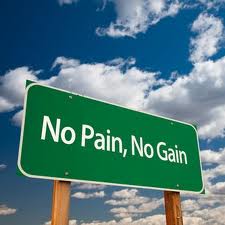
No Pain, No Gain, Right?
One of the most common questions physical therapists and athletic trainers are asked in the clinic and on the field goes something like this: “Is it ok to do _____ if it hurts? I can usually stand the pain and push through it, and sometimes is goes away after 10-15 minutes. Is that wrong?” The concept of ‘No Pain No Gain’ ranks right up there with ‘PT really means Pain and Torture (ha-ha)’ as one the least favorite things we hear when trying to get someone healthy.
The first distinction to make is between pain and work. Pain can be defined as sharp, stabbing, tooth-achy, deep, or shooting. Most commonly, pain occurs at or very close to a joint. These sensations are usually associated with actual tissue damage or irritation. Pain is a built-in alarm system in our body that the tissue being abused isn’t happy (warning: link isn’t for the squeamish). Work, on the other hand, is discomfort experienced in the muscles surrounding a joint. This is the burning or mildly-achy sensations we experience when working out or when performing exercise at a high intensity. This is a normal side-effect of muscle fatigue and does not pose any real danger. In fact, if you don’t experience this during a work-out, you probably aren’t getting the maximum return on your effort.
Now that the distinction has been made, we can better answer the original question. Any pain that makes you limp or makes it difficult to lift or move a body part is a signal that something isn’t right.
If mild pain is present during the first few minutes of exercise, it is typically ok to continue at a lower intensity. If the pain lasts more than 3-5 minutes, however, the activity should be stopped. Getting used to the pain is a natural process in the body. Imagine someone tapping their finger on your shoulder while you are watching TV. If they continue to do so for a few minutes, you will get used to the sensation and your body will ignore it, allowing you to enjoy the show. The tapping is still there, but your body filters out this information and gives priority to other sensory input.
Pain works in a similar manner. If the pain is present for more than a few minutes, your body gets used to it. Whatever is causing the pain is still there, you have just stopped feeling it. So, for this reason, it is important to stop because your body is being damaged in some way, and continuing can cause further damage.
Another good example of how pain and exercise interrelate is to think of your reaction to a small injury. Let’s say you bang your thumb with a hammer. What is the first thing you do? Most people shake the injured limb or squeeze it between their legs or in their armpit. Whether you realize it or not, you are using a different sensory system to override the pain signal. The pressure on your hand between the legs or the vibration you sense from the shaking allows the brain to focus on different information. In the same way, if you experience pain while running, your brain only notices the pain for a short while, and then starts to feel your arms swinging, your feet pounding the ground, etc. But just as the hammered finger still has damaged tissue, the tissue creating the pain signal during your run is still in trouble.
If you need help distinguishing between pain and work during your favorite fitness or other activity, call our facility to set up a free consultation. Our physical therapists are experts at sorting through those ‘does it hurt or is it hard’ questions!
Image courtesy of http://www.thecredocompany.com






